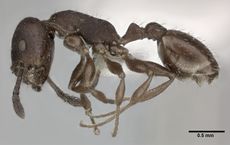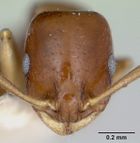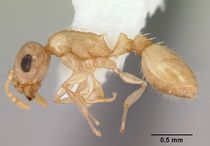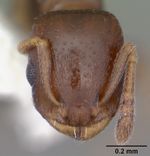Key to the New World Temnothorax
This worker key is based on: Mackay, W. P. 2000. A review of the New World ants of the subgenus Myrafant, (genus Leptothorax) (Hymenoptera: Formicidae). Sociobiology. 36:265-444.
You may also be interested in
1
- Petiole and postpetiole armed with spine-like protuberances . . . . . Subgenus Nesomyrmex (see Kempf, 1959 for key to species)
- Petiole and Postpetiole without spine-like processes . . . . . 2
2
return to couplet #1
- Petiole with elongate peduncle; mesosoma either strongly arched or mesopropodeal suture deeply impressed . . . . . 3
- Petiole without an elongate peduncle, or dorsum of promesonotum flat or feebly convex in profile; mesopropodeal suture at most feebly impressed (except for T. hispidus) . . . . . 4
3
return to couplet #2
- Dorsum of mesosoma strongly arched . . . . . Subgenus Macromischa (see Baroni Urbani 1978 for key to species)
- Dorsum of promesonotum not strongly convex in profile; mesopropodeal suture deeply impressed . . . . . Subgenus Dichothorax, T. pergandei (see Mackay, 1993)
4
return to couplet #2
- Clypeus without carinae on medial surface, but usually with carinae present anterior to frontal carinae, middle of clypeus usually concave with longitudinal depression; antennal scapes often with erect or suberect . . . . . Subgenus Leptothorax (see Creighton, 1950:257-258 for key to species) and genus Formicoxenus (see Francoeur and Loiselle, 1985 for assistance with species identifications).
- Clypeus with medial, longitudinal carina, in addition to several lateral carinae; scape usually without erect hairs . . . . . 5 (Subgenus Myrafant)
5
return to couplet #4
- Posterior corner of propodeum completely rounded, without evidence of angles or spines; Mexico . . . . . Temnothorax striatulus
- Posterior corner of propodeum with angles or spines; widely distributed in North America, including Mexico . . . . . 6
6
return to couplet #5
- Antennae with 12 segments (usually easier to count with funiculus held at an oblique angle) . . . . . 7
- Antennae with 11 segments . . . . . 49
7
return to couplet #6
- Disc (at least basal 1/3) of first tergum of gaster predominantly reticulopunctate, (sculpture may be very weak and difficult to see); Nevada to Colorado, Arizona to west Texas south to northern Mexico . . . . . 8
- Entire disc (except possibly region immediately posterior to connection of postpetiole) of first tergum of gaster completely smooth, polished and shining; widely distributed in North America (including Medco and Guatemala) . . . . . 12
8
return to couplet #7
- Propodeal angles dentiform or bump-like; mesosomal outline varies, often impressed . . . . . 9
- Propodeal spines well formed, often half as long as, or even longer than, the distance between their bases; mesosoma not impressed at the mesopropodeal suture . . . . . 10
9
return to couplet #8
- Mesosoma somewhat impressed at mesopropodeal suture; head mostly rugose with few punctures . . . . . Temnothorax hispidus
- Mesosoma not depressed at mesopropodeal suture; head heavily and densely punctate . . . . . Temnothorax andersoni
10
return to couplet #8
- Eye oval in shape; dorsum of mesosoma with coarse, longitudinal rugae; shape of petiolar node varies; hind femur greatly thickened; Arizona and Nuevo Leon . . . . . 11
- Eye elongate, kidney shaped; dorsum of mesosoma finely punctate with no evidence of rugae; petiolar node in profile with relatively sharp apex; hind femora not greatly thickened; NV, CO, NM, TX . . . . . Temnothorax obliquicanthus
11
return to couplet #10
- Petiolar node in profile nearly as broad apically as basally; propodeal spines nearly as long as distance between them; Arizona . . . . . Temnothorax silvestrii
- Petiolar node with sharp apex; propodeal spines short, less than ½ distance between bases; Mexico (Nuevo Leon) . . . . . Temnothorax rugosus
12
return to couplet #7
- Dorsum of mesosoma very smooth and shiny, entirely devoid of sculpture except for small and widely spaced piligerous punctures . . . . . 13
- Dorsum of mesosoma sculptured, or at least never entirely smooth and shining, if mostly smooth and shining, at least dorsum of propodeum sculptured . . . . . 14
13
return to couplet #12
- Propodeal spines long, (longer than broader at their bases); Colorado . . . . . Temnothorax schmittii
- Propodeal spines short (shorter than distance between bases); widely distributed in western North America . . . . . Temnothorax nitens
14
return to couplet #12
- Eyes tiny, maximum length about 1/2 distance between base of mandible and anterior edge of eye; California . . . . . Temnothorax ocellatus = Temnothorax andrei
- Eyes larger, maximum diameter ranging from ½ length between base of mandible and anterior edge of eye, to about as long as this distance; widely distributed . . . . . 15
15
return to couplet #14
- Dorsum of head at least in part smooth and shining; if head is partly sculptured, at least central area smooth and shining and petiolar node is angulate in profile, with relatively sharp apex . . . . . 16
- Head largely or entirely sculptured, surface feebly shining only between sculpture, or completely opaque; if head is partially smooth and shining, then petiolar node is rounded and blunt or obliquely truncate in profile, and/or propodeal spines are about as long as the distance between their bases . . . . . 29
16
return to couplet #15
- Dorsum of head entirely smooth and polished, striae or rugae present on sides of head; southern Texas, Mexico and Guatemala . . . . . 17
- Dorsum of head partially to mostly smooth and shining, area adjacent to broad, central, shining strip with sculpture, often very fine; widely distributed in USA and Mexico . . . . . 21
17
return to couplet #16
- Propodeal spines well developed, nearly half as long as distance between bases; semicircular striae posterior to insertions of antennae present or absent . . . . . 18
- Propodeal armature consisting of only small angles or tiny spine; semicircular striae present posterior to insertions of antennae . . . . . 19
18
return to couplet #17
- Semicircular striae absent posterior to insertion of antennae . . . . . Temnothorax stollii
- Semicircular striae present posterior to insertion of antennae . . . . . Temnothorax bicolor
19
return to couplet #17
- Hairs on scape decumbent; hairs on dorsum of head very fine and dispersed; widely distributed in Texas and Mexico . . . . . 20
- Hairs on scape suberect to nearly erect; hairs on dorsum of head coarse and abundant; Michoacon . . . . . Temnothorax brevispinosus
20
return to couplet #19
- Mesopleuron and sides of propodeum with rugae; side of pronotum predominantly smooth and glossy; Hidalgo, Morelos and Nuevo Leon . . . . . Temnothorax manni
- Mesopleuron and sides of propodeum punctate; side of pronotum with fine striae; western Texas and Coahuila . . . . . Temnothorax bristoli
21
return to couplet #16
- Petiolar node blunt in profile; nearly entire head smooth and shining, area adjacent to polished central strip with very fine sculpture . . . . . 22
- Petiolar node in profile with angulate apex; entire dorsum of head often smooth and shining, at least posterior half of head in part smooth and shining, with broad, central strip which is free of sculpture, extending posteriorly to vertex . . . . . 24
22
return to couplet #21
- Entire dorsum of head with fine striae; dorsal surface of postpetiole smooth and shining; nests under stones . . . . . Temnothorax mexicanus
- Central region of dorsum of head mostly free of sculpture, region adjacent to central strip with fine punctures or costulae; dorsal surface of postpetiole densely punctate . . . . . 23
23
return to couplet #22
- Eyes small, distance from insertion of mandible to anterior border of eye about 1.2 X maximum diameter of eye; New Mexico and southern Texas . . . . . Temnothorax cokendolpheri
- Eyes larger, distance from insertion of mandible to anterior border of eye about equal to maximum eye diameter; central Mexico (state of Mexico) . . . . . Temnothorax punctithorax
24
return to couplet #21
- Much of the dorsum of head smooth and shining; petiolar node in profile with very sharp apex . . . . . 25
- Head usually with only a central strip free of sculpture; petiolar node in profile with a relatively sharp apex . . . . . 26
25
return to couplet #24
- Posterior surface of petiolar node with punctures; New Mexico . . . . . Temnothorax melinus = Temnothorax nitens
- Posterior surface of petiolar node with fine rugulae; Oregon, California and Arizona . . . . . Temnothorax mariposa = Temnothorax nitens
26
return to couplet #24
- Dorsum of pronotum mostly glossy with a few longitudinal fine striae, but with little or no evidence of punctures; region between propodeal spines finely punctate, nearly smooth . . . . . Temnothorax nitens
- Dorsum of pronotum punctate with little evidence of striae; region between spines sculptured with line rugae, or punctate . . . . . 27
27
return to couplet #26
- Propodeal spines well developed, at least ½ length of distance between bases of spines, often as long as distance . . . . . Temnothorax maryanae = Temnothorax nevadensis
- Propodeal spines small to tiny, total length less than ½ distance between bases . . . . . 28
28
return to couplet #27
- Dark brown; propodeal armature consisting of blunt angles, region between propodeal angles with fine transverse rugae; known only from the state of Chihuahua, Mexico, nesting under bark of cottonwood trees . . . . . . Temnothorax adustus
- Light yellow brown; propodeal spines small, but acute, region between propodeal spines punctate; California (in litter) . . . . . Temnothorax chandleri
29
return to couplet #15
- Head densely and evenly punctate, never with central strip free of sculpture, without striae or rugae, or rarely with punctures in rows that may form weak striae; pale yellow to light brown with black eyes . . . . . 30
- Head usually with striae or rugae as well as punctures right), the entire dorsal surface usually feebly shining, often central strip is without sculpture; color yellow, yellow brown to dark brown . . . . . 35
30
return to couplet #29
- In profile, node of petiole relatively sharp . . . . . Temnothorax coleenae
- In profile, node of petiole truncate or rounded . . . . . 31
31
return to couplet #30
- Relatively large species, total length greater than 3mm; petiolar node broadly rounded in profile . . . . . Temnothorax punctaticeps
- Smaller species, total length less than 3mm; petiolar node more or less truncate or acute in profile . . . . . 32
32
return to couplet #31
- Propodeal spines small, but developed; hairs on petiole blunt and thickened: Texas . . . . . 33
- Propodeal spines poorly developed, consisting simply of angles; hairs on petiole fine with relatively sharp tips; Mexico (Nuevo Leon) . . . . . Temnothorax punctatissimus
33
return to couplet #32
- Eyes relatively small (maximum diameter < 0.15mm), maximum diameter less than distance of anterior edge to base of mandible; recorded only from near Austin and from the Chisos Mountains of western Texas . . . . . Temnothorax terrigena
- Eyes relatively large (maximum diameter > 0.20mm), maximum diameter about equal to distance from insertion of mandible; found in deserts in west Texas . . . . . 34
34
return to couplet #33
- Color nearly white; dorsum of pronotum with poorly developed rugulae; petiolar node truncate . . . . . Temnothorax liebi
- Color pale brown; dorsum of pronotum with distinct rugae; node of petiole rounded . . . . . Temnothorax bestelmeyeri
35
return to couplet #29
- Propodeal spines joined at bases by distinct transverse ridge or welt which lies at angle between dorsal and posterior faces of propodeum; east central Texas . . . . . Temnothorax obturator
- Propodeal spines not joined at base by transverse welt; widely distributed . . . . . 36
36
return to couplet #35
- Head with rugae as well as punctures; petiolar peduncle elongate and petiole with square node as seen in profile; Baja California .... . . . . . Temnothorax peninsularis
- Head mostly or entirely punctate, or with striae or rugae; petiolar peduncle short (and node may be square in profile) or if somewhat elongate, petiolar node rounded; widely distributed . . . . . 37
37
return to couplet #36
- Postpetiole less than 1.5 times as wide as total width of petiole, as seen from top . . . . . 38
- Total width of postpetiole at least 1.5 times as wide as total width of petiole, occasionally twice as wide . . . . . 43
38
return to couplet #37
- Petiole and postpetiole with coarse, long, thick, clavate hairs, about 4-10 on petiole and 12-20 on postpetiole; dorsum of head with rugae, with intrarugal spaces shining; dorsum and especially sides of mesosoma with well defined rugae; node of petiole truncate; southeastern Arizona (Cochise Co.) . . . . . Temnothorax stenotyle
- Without all of above characteristics; hairs on petiole and postpetiole slightly spatulate, or only blunt tipped; dorsum of head strongly striate, mixed with punctures or with fine rugulae . . . . . 39
39
return to couplet #38
- Propodeal spines at least ½ as long as distance between bases; dark brown in color . . . . . 40
- Length of propodeal spines usually less than 7z distance between bases, usually consisting of tiny spines or simply angles (if longer, apex of petiole sharp as seen in profile); pale yellow or light yellowish brown, head and part of gaster may be light-brown . . . . . 42
40
return to couplet #39
- Propodeal spines longer than the distance between their bases; petiole with moderately sharp apex, which is "pinched" as seen from above; postpetiolar node one and one fourth times broader than long, sides subparallel; usually nests in cynipid galls in canyon live oak (Quercus chrysolepis Liebm.) in California . . . . . Temnothorax gallae
- Propodeal spines about ½ to as long as distance between bases; petiolar node rounded or truncate in profile, apex not “pinched” as above; nests under rocks and duff, or simply ln soil, and is common and widely distributed in western U.S.A. . . . . . 41
41
return to couplet #40
- Dorsum of pronotum with longitudinal rugae; intrarugal spaces on head of female smooth and shining . . . . . Temnothorax nevadensis
- Dorsum of pronotum predominantly punctate, with a few striae; intrarugal spaces on head of female punctate . . . . . Temnothorax lindae = Temnothorax nevadensis
42
return to couplet #39
- Petiole in profile with sharp apex; propodeal spines nearly ½ length of distance between bases; mesosoma with evidence of striae, especially on sides; Colorado, Wyoming . . . . . Temnothorax furunculus
- Petiole in profile with rounded or somewhat truncated apex; propodeal spines shorter than ½ distance between bases; mesosoma completely punctate with no evidence of striae; western North America (CA, NV, AZ, NM, Baja California Norte) . . . . . Temnothorax andrei
43
return to couplet #37
- Dorsum of postpetiole coarsely, and predominantly transversely, reticulo-rugose; node of petiole truncate in profile . . . . . Temnothorax texanus
- Dorsum of postpetiole punctate or granulose rarely reticulo-rugose, rugae often present on sides of node, node of petiole in profile occasionally with sharp apex . . . . . 44
44
return to couplet #43
- Postpetiole very large, at least 1.6 X as wide as petiole and half as wide as gaster; New York south to Florida . . . . . Temnothorax davisi = Temnothorax texanus
- Postpetiole usually less than 1.6 X as wide as petiole and less than half as wide as gaster; middle and western USA south into western Mexico . . . . . 45
45
return to couplet #44
- Sculpture on dorsum of head consisting primarily of striolae or very fine rugulae (or finely punctate); side of petiole without rugae or rarely with rugulae; often concolorous pale yellowish-brown (rarely dark brown), gaster often slightly darker . . . . . 46
- Sculpture on head consisting of fine rugae; side of petiole with rugae which are not obscured by punctures; concolorous dark brown; middle and western USA . . . . . Temnothorax tricarinatus
46
return to couplet #45
- Side of pronotum weakly shining with well-defined parallel striae; Mexico (Michoacon and Hidalgo) . . . . . 47
- Side of pronotum dull and granulate or punctate, or with poorly defined parallel striae; southwestern USA and NW Mexico . . . . . 48
47
return to couplet #46
- Propodeal spines poorly developed, but present; rugulae on pronotum well defined and extending posteriorly onto mesonotum . . . . . Temnothorax rugulosus
- Propodeal spines consisting of tiny angles; fine rugae on pronotum poorly defined, dorsum of mesonotum punctate . . . . . Temnothorax rugithorax
48
return to couplet #46
- Propodeal armature consisting of simple angles; light brown . . . . . Temnothorax carinatus
- Propodeal spines well developed, length at least1/3 the distance between bases of the spines; petiole obliquely truncate; dark brown . . . . . Temnothorax neomexicanus
49
return to couplet #6
- Propodeal spines short or dentiform, length less than ½ distance between bases; often concolorous dark brown . . . . . 50
- Propodeal spines longer than ½ distance between bases; ranging from yellowish-brown to concolorous dark-brown or bicolored . . . . . 53
50
return to couplet #49
- Dorsum of head densely punctate, mixed with striae; distributed over much of the United States . . . . . 51
- Dorsum of head partially smooth and shining; New Mexico and Mexico . . . . . 52
51
return to couplet #50
- Node of petiole broadly rounded; eastern half of USA (west to Kansas, Oklahoma & Texas) . . . . . Temnothorax schaumii
- Node of petiole with sharp apex; known only from California . . . . . Temnothorax oxynodis
52
return to couplet #50
- Dorsum of pronotum with rugae; bicolored (head and gaster black, mesosoma, legs, petiole & postpetiole orange) . . . . . Temnothorax emmae
- Dorsum of pronotum ranging from smooth to punctate; concolorous dark brown . . . . . Temnothorax whitfordi
53
return to couplet #49
- Dorsum of head nearly smooth, shining; propodeal spines often nearly as long as distance between tips . . . . . 54
- Entire dorsum of head covered with sculpture; propodeal spines often shorter than distance between tips . . . . . 55
54
return to couplet #53
- Propodeal spines form an angle of nearly 180° with dorsum of propodeum when viewed in profile; common and widely distributed in eastern United States . . . . . Temnothorax longispinosus
- Propodeal spines form an angle of about 150° with dorsum of propodeum when viewed in profile; known only from Alabama and North Carolina . . . . . Temnothorax tuscaloosae
55
return to couplet #53
- Head with very delicate longitudinal rugae, not much coarser than intrarugal sculpture and often forming reticulations with it; eastern United States . . . . . 56
- Head with coarse longitudinal rugae which are notably heavier than the intrarugal sculpture and do not form reticulations with it; mostly western United States . . . . . 58
56
return to couplet #55
- Propodeal spines set close together at bases, spines about twice as long as distance between bases; postpetiole, from above, sub-quadrate, slightly broader than long . . . . . Temnothorax curvispinosus
- Propodeal spines well-separated at bases, about as long as the distance between bases; postpetiole, from above, notably broader than long . . . . . 57
57
return to couplet #56
- Propodeal spines of worker and female tapered toward apex, with sharp tip; female with large, oblong eye (greatest diameter about 0.25mm); common and widely distributed in eastern half of USA . . . . . Temnothorax ambiguus
- Propodeal spines of female blunt tipped and of approximately the same diameter along entire length (worker unknown); female with small, round eye (maximum diameter about 0.12mm); known only from Washington DC, may be workerless parasite of T. curvspinosus. . . . . Temnothorax minutissimus
58
return to couplet #55
- Intrarugal punctures of head very dense and coarse, areas where they occur dull; southeastern United States . . . . . 59
- Intrarugal punctures of head fine and somewhat separated, areas where they occur feebly shining; western United States . . . . . 60
59
return to couplet #58
- Dorsum of postpetiole lightly punctate, not completely opaque; dorsum of mesonotum with longitudinal rugae largely replaced by punctures; propodeal spines about half as long as distance between tips . . . . . Temnothorax bradleyi
- Dorsum of postpetiole heavily punctured and completely opaque; dorsum of mesonotum with longitudinal rugae not replaced by punctures; propodeal spines more than half as long as distance which separates tips . . . . . Temnothorax smithi
60
return to couplet #58
- Relatively small, total worker length approximately 2.5mm, yellowish-borwn with dorsum of head slightly darker, rarely bicolored; nests under rocks . . . . . Temnothorax rugatulus
- Large ants, total worker length over 3mm; bicolored, head and gaster black, mesosoma dark reddish brown; nests in branches of oak trees . . . . . Temnothorax josephi
























































































